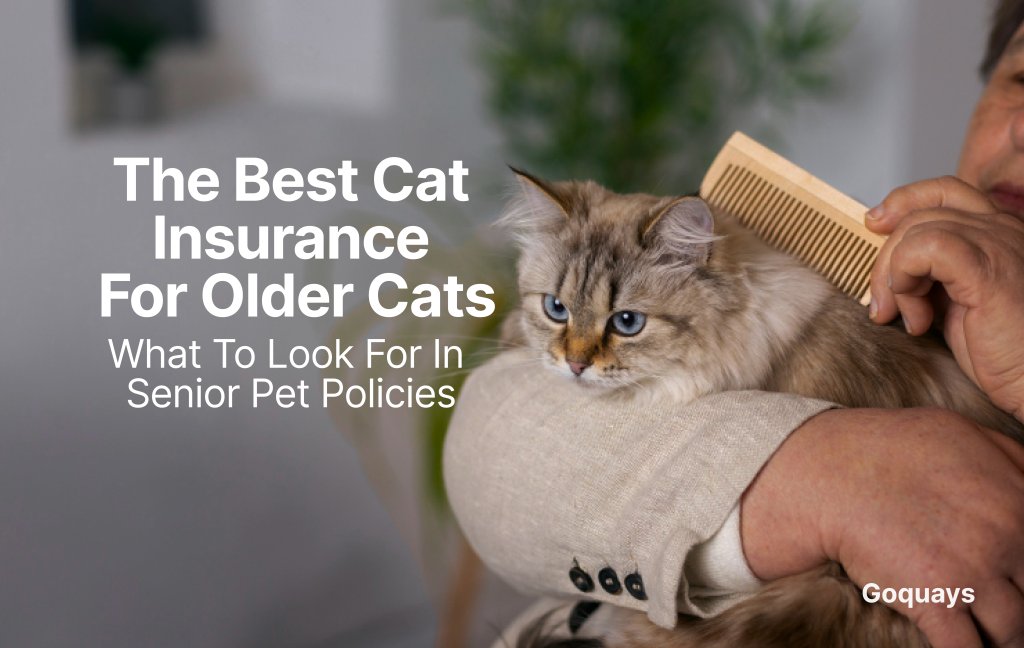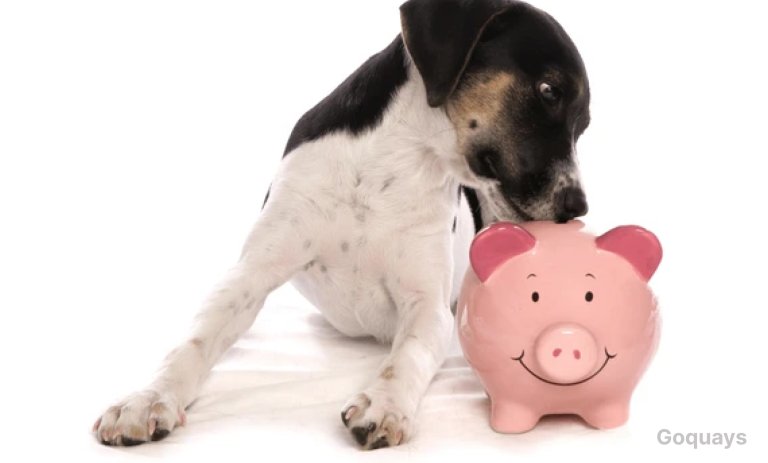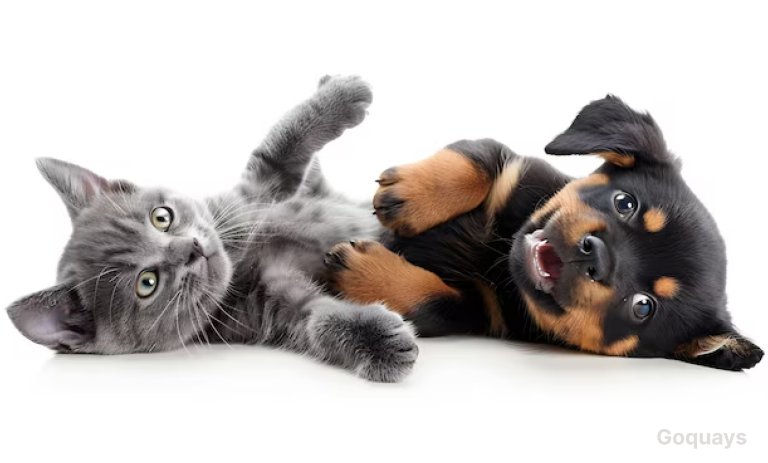When it comes to keeping our pets healthy, most pet owners focus on the obvious essentials like diet, regular vet check-ups, plenty of exercise, play time and a cosy place to sleep. But most parents ignore their pet’s food and water bowls. It is important for pet parents to be curious on how often should you clean pet bowl.
According to the NSF International Germ Study, pet bowls are among the dirtiest items in the average household, ranking even higher than toilet seats and kitchen bins in terms of bacterial contamination. The study found that pet bowls often harbour Salmonella, E. coli, and yeast, especially when not cleaned regularly. Meanwhile, research published in the Journal of Food Protection confirms that infrequent cleaning allows biofilms to form, which shield bacteria from being easily washed away.
And while that may sound dramatic, the health consequences, particularly for young, elderly, or immunocompromised pets, can be very real.
So, how often should you be cleaning your pet’s bowls? In this post, we will explain to you how often you need to wash your pet’s bowls, when to wash your pet’s bowls, and the best bowl quality to choose for your pet.
Why is it important to clean your pet’s bowl?

Your pet’s bowl can have a huge impact on their overall health. Food and water bowls are in constant contact with your pet’s mouth, saliva, leftover food, and even bits of dirt or bacteria picked up from the floor or outside. Over time, this creates the perfect breeding ground for microorganisms.
According to research by NSF International, these bowls can harbour dangerous bacteria like E. coli, Salmonella, MRSA, and Campylobacter. This can cause gastrointestinal issues, vomiting, diarrhoea, and more serious infections in pets. This can even be passed on to individuals living with the pet, especially children, through casual contact.
Organisations like the Blue Cross and PDSA emphasise on how proper pet hygiene is important when welcoming a pet (dog or cat) into your home. Having dirty bowls puts your pet at bacterial risk and also causes mould and biofilm. Biofilm can protect harmful bacteria, making it harder to eliminate with just a quick rinse.
Your pets don’t just get sick as a result of dirty bowls, it also affects their behaviour. Your pets may refuse to eat or drink from bowls that smell off or taste “wrong” to them. This can lead to dehydration, fussy eating, or even anxiety around mealtime. Therefore, cleaning your pet’s bowl is a simple but effective way to prevent illness.
How often should you clean your pet’s bowls?
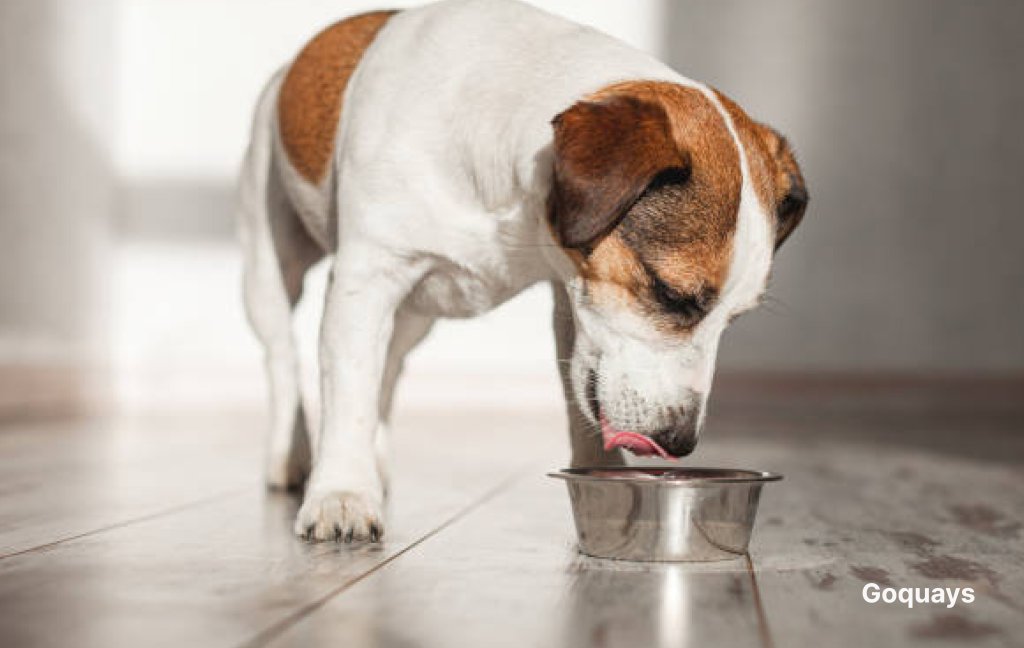
A lot of pet owners are curious as to “how often should I clean my pet’s bowls?. The short answer? More often than you probably are.
According to veterinarians and hygiene experts, your pet’s food bowl should be washed after every meal, just like you would clean your plate. This is important if you feed your pet wet food, raw food, or a homemade diet, all of which spoil quickly and create ideal conditions for bacteria to grow.
If you feed your pet dry food, don’t assume you can get away with just wiping bowls. This is because saliva, crumbs and oil remnants can still accumulate and form biofilm over time.
For water bowls, they should be cleaned and refilled with fresh water at least once a day. In hot weather, you may be required to clean them more frequently to prevent slime, algae, and bacterial growth, especially in households using hard water
Here’s a quick reference guide:
| Body type | Recommended Cleaning |
| Food(wet/raw) | After every meal |
| Food(dry) | Daily |
| Water bowl | Daily( more frequent in summer) |
Remember not to forget washing food mats or feeding stations, too, because they can also trap food particles and bacteria just as easily.
Cleaning routines for cleaning pet bowls
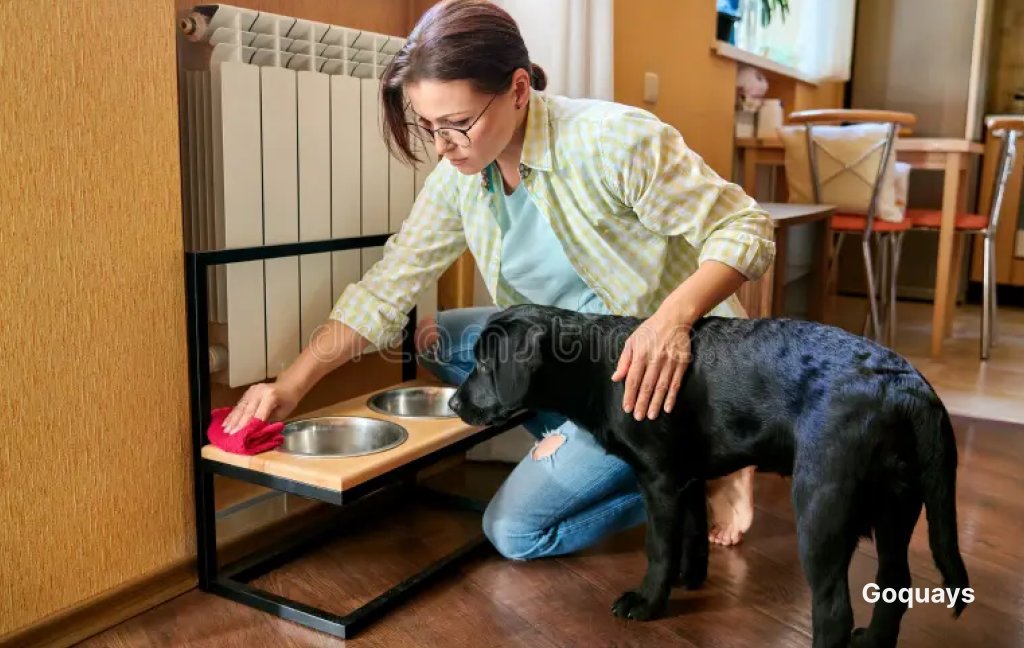
By following a proper cleaning routine, you can help manage your pet’s health and hygiene
Daily cleaning routine: step-by-step
- Rinse immediately after feeding: After your pet finishes eating, rinse the bowl under warm water to remove leftover food and saliva. This helps prevent biofilm from forming and makes full cleaning easier.
- Wash with hot soapy water: Make use of a dedicated sponge or cloth (separate from your regular dishes) and wash the bowl using hot water and mild dish soap.
- Dry properly: Allow bowls to air dry completely or dry them with a clean towel. Avoid stacking damp bowls, which can encourage mould.
Weekly cleaning
Every week, give your pet’s bowl a deep clean using;
- White vinegar soak: Fill the bowl with one part white vinegar and one part hot water. Let sit for 10–15 minutes, then scrub and rinse.
- Baking soda paste: For stubborn odours, mix baking soda with a little water to form a paste, scrub, then rinse well.
- Pet-safe disinfectants: Choose non-toxic, fragrance-free products designed for pet use. Ensure all cleaning products are thoroughly rinsed off.
Dos and Don’ts of your pet bowls
Dos:
- Use a separate bowl for food and water
- Clean elevated stands and feeding mats as well
Don’t
- Do not use bleach unless heavily diluted and rinsed thoroughly
- Do not leave your pet’s bowls outside where slugs or bird droppings may contaminate them.
What happens if you don’t clean them enough?
Here are some of the most common risks associated with dirty bowls:
- Bacterial Infections
Harmful bacteria such as E. coli, Salmonella, and Campylobacter can cause vomiting, diarrhoea, lethargy, and appetite loss both dogs and cats. These symptoms can range from mild to severe and may require veterinary treatment, potentially leading to expensive vet bills.
- Fungal and mould exposure
When not cleaning your pet bowls, especially in damp environments, mould and yeast can quickly grow in the water bowls or bowls left outside, which can lead to your pets experiencing allergic reactions, respiratory irritation or skin problems due to prolonged exposure.
- Oral and dental issues
Biofilm buildup contains bacteria that can lead to gum disease or oral infections if pets consistently lick or eat from contaminated surfaces.
- Cross-contamination risks for humans
Your pets’ dirty bowls can also put you (pet parent) at certain health risks. Family members, especially children who are easily prone to diseases, when they accidentally come into contact with a contaminated pet bowl, they increase their risk of zoonotic(animal-to-human) disease transmission.
In short, inconsistent cleaning may seem harmless at first, but it can result in serious health issues for your pet and your family.
Choosing the right bowl quality
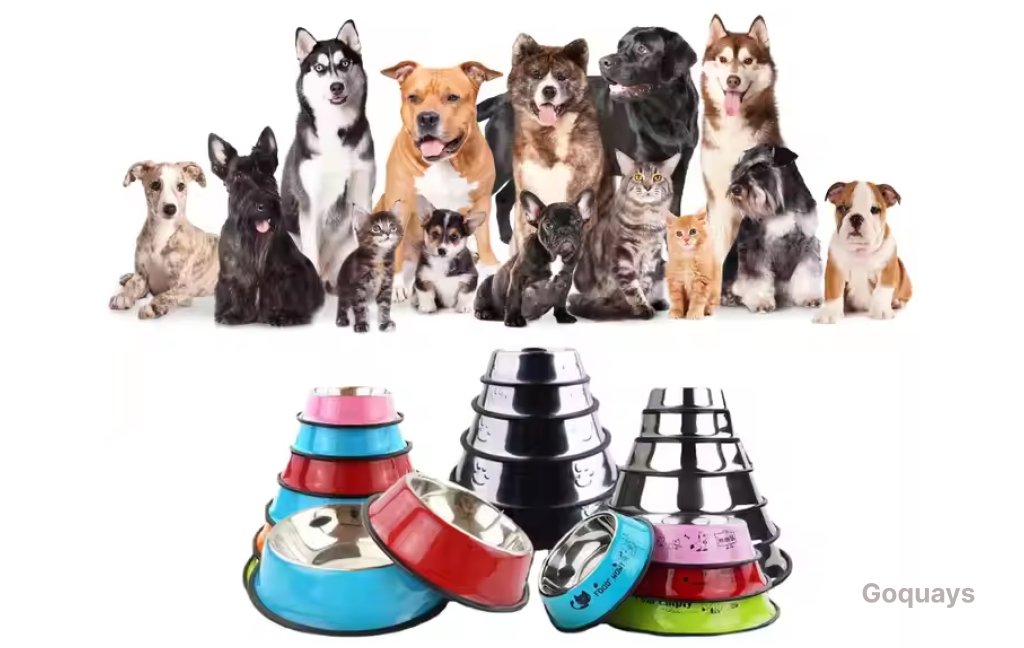
The type of bowl quality you use can determine how easy it is to maintain proper hygiene. Here are some pet bowl qualities we recommend
- Stainless steel: A stainless steel bowl is the best choice for your pet as it is the most hygienic option. It is dishwasher safe, doesn’t scratch easily, which means bacteria have nowhere to hide. It is also rust-resistant and long-lasting, making it the best recommendation by vets and a go-to option for pet parents.
- Ceramic: These bowls are known for their aesthetics, but to use a ceramic bowl for your pet, ensure it’s glazed with lead-free, pet-safe coating. While a ceramic bowl is easy to clean, it can chip or crack, creating crevices for breeding room for bacteria to grow. Replace any chipped bowl if you have one.
- Plastic: Plastic bowls are convenient, lightweight and cheap, but the downside is its easily scratched from basic daily use and your pets’ rough tongues. Scratches sustained on these bowls can, over time, breed ground for bacteria, and your pet can even develop plastic dermatitis (chin acne) a allergic reactions or bacterial buildup.
Tips for a multi-pet household
Here are some tips you should follow if you keep more than one pet
- Make use of separate bowls: Always provide individual bowls for food and water for each pet. Using the same bowl for food and water increases the risk of cross-contamination, especially if one pet is sick or has a weakened immune system. Pets like cats may refuse to eat from a bowl that smells like another animal.
- Label bowls: To make things easy and hygienic, label each bowl according to its usage. Doing this helps you avoid mix-ups, especially if your pets have different diets, medications, or allergies.
- Clean bowls more frequently: Regular cleaning is very important when multiple pets use the same bowl. Overcrowded feeding areas can harbour more germs. In multi-pet homes, a little organisation goes a long way toward ensuring every pet eats safely, calmly, and cleanly.
Considerations for UK pet owners
Pet care is never one-size-fits-all, and here in the UK, there are a few unique factors that can affect how often and how thoroughly you should clean your pet’s bowls.
- Hard water and limescale build-up: Certain areas in Southern and Eastern England experience hard water, which can lead to limescale deposits in water bowls. Over time, these hard water marks can harbour bacteria and affect the taste of drinking water, leading to your pets drinking less water. But regularly washing and occasional vinegar soaks can help prevent this.
- Seasonal changes and bacterial growth: During warmer months, bacteria and mould grow quickly in stagnant water and leftover food. If your pet bowls are naturally outside, then they are at risk of slug slime, insects, or algae, which can cause parasites or toxins. On the other hand, during cold months, bowls left outside could freeze u,p leading to less water intake.
- Raw feeding trends in the UK: More UK pet parents are now incorporating raw diets, which means proper bowl hygiene is now more important. Raw meat can carry salmonella or listeria, posing risks to both pets and humans. Bowls used for raw feeding should be cleaned immediately after every meal with hot, soapy water.
Eco-friendly cleaning: If you are environmentally conscious, opt for biodegradable, pet-safe soaps and sustainable stainless steel or ceramic bowls. Some brands now offer eco-friendly cleaning products suitable for pet dishes. Being aware of these specific concerns can help you maintain a safer, cleaner feeding routine year-round.
Conclusion
Keeping your pet’s food and water bowls clean is an important step in ensuring a healthy pet. While it’s easy to overlook, especially when you have other important things to get done, think of it as a daily routine like washing your dishes.
This regular washing prevents the build-up of harmful bacteria, reduces the risk of illness, and ensures your pet enjoys their meals safely and happily. It also helps you maintain a cleaner home, protect vulnerable family members, and potentially avoid costly vet bills related to hygiene-related infections.
So make sure to clean food bowls after every meal, wash water bowls at least once a day, choose the right bowl quality(stainless steel) and deep clean the bowls weekly, especially in warm season or if you have a multipet household.
By making these small, consistent efforts, you are actively supporting your pet’s wellbeing and showing them just how much you care.

